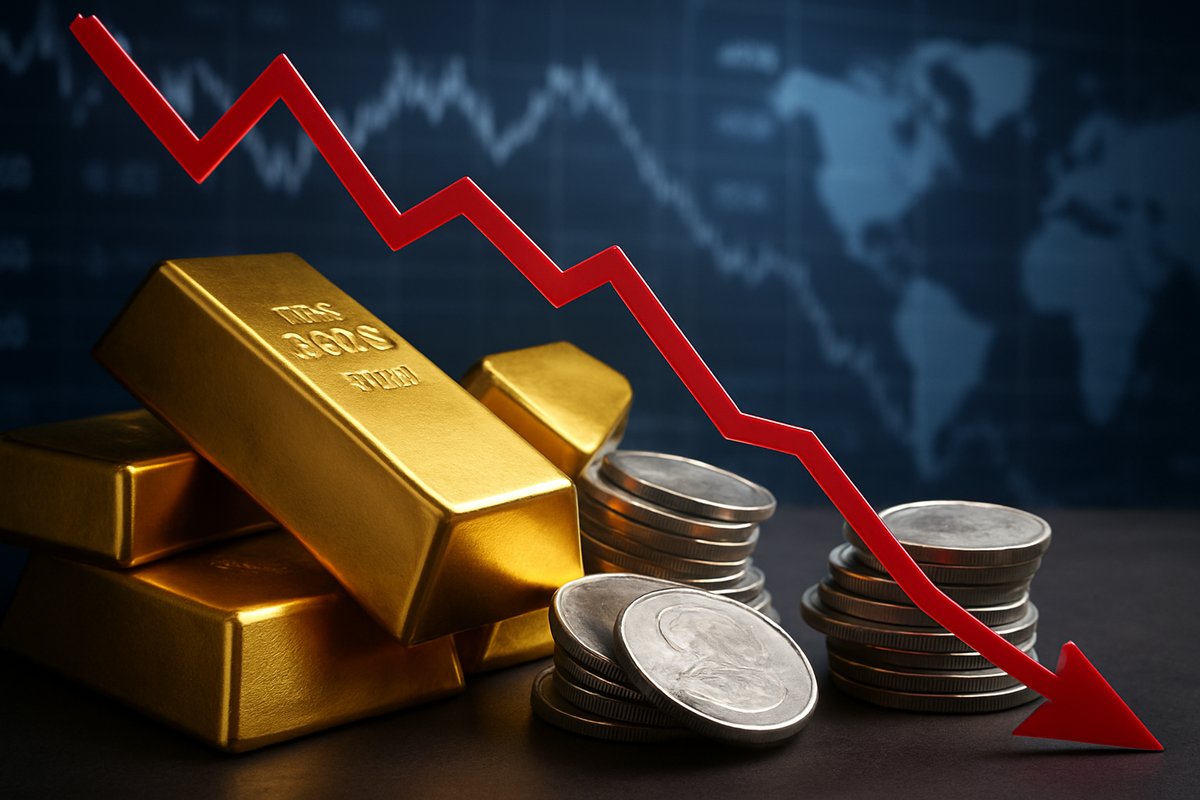
The precious metals market has been rocked by a dramatic and steep correction, with gold and silver experiencing their most significant single-day percentage drops in years around October 21-22, 2025. This sharp downturn comes on the heels of an unprecedented rally that saw both metals reach historic highs, leaving investors scrambling to understand the immediate implications for their portfolios and the broader financial landscape. While the immediate reaction has been one of heightened volatility and profit-taking, many market observers are now asking whether this presents a strategic buying opportunity or signals a more profound shift in investor sentiment.
This sudden reversal has reset expectations, but its causes are multifaceted, ranging from technical market conditions to shifts in global economic sentiment. The correction serves as a stark reminder of the inherent volatility even in traditionally safe-haven assets, prompting a re-evaluation of strategies for both short-term traders and long-term investors.
The Precipitous Drop: Unpacking the Recent Correction
The week of October 21, 2025, will be etched in the memory of precious metals investors. Gold, which had been enjoying an extraordinary rally, plunged by as much as 6.3% in a single day, marking its largest single-day percentage drop since mid-April 2013. Spot gold briefly traded near $4,106.46 per troy ounce, a significant retreat from its record high of $4,381.21 per ounce achieved just days prior on October 20. Silver mirrored this slide, retreating by nearly 9% to $48.50 per ounce, its steepest decline since February 2021. The declines continued into October 22, extending losses for a third consecutive day, with December 2025 gold futures falling over 2% to an intraday low of $4,021.91 and silver futures dropped nearly 2% to $46.82 per troy ounce. In India, gold prices corrected from Rs 1.3 lakh per 10 grams to approximately Rs 1.25 lakh, and silver slipped around 12% since October 18, 2025.
This sharp correction followed an extended period of historic gains. In the preceding four months, gold had surged from approximately $3,300 per ounce to $4,400 per ounce, gaining nearly $1,100 per ounce and achieving a 31% increase in a nine-week rally. Silver’s ascent was even more dramatic, with a 45% rise in the same period, nearly doubling in price over the past year. This rapid appreciation set the stage for an inevitable pullback, driven by several key factors.
Primary among the causes was aggressive profit-taking. After such substantial and rapid gains, many investors seized the opportunity to lock in profits at unprecedented price levels. This wave of sell-offs was exacerbated by a strengthening U.S. dollar, which made dollar-denominated gold and silver more expensive for international buyers, thereby dampening demand. Simultaneously, an improvement in global risk sentiment, possibly influenced by positive trade talks between China and the U.S. and easing geopolitical tensions, reduced the appeal of safe-haven assets. This "risk-on" shift saw funds rotate from precious metals back into equity markets. Technical indicators also played a crucial role; the preceding rally had left both gold and silver in "massively stretched" and "persistently overbought conditions," making a correction "inevitable" and "overdue." Finally, a moderation in physical demand from key Asian buyers, particularly India, following the Diwali festive season, contributed to the downward pressure. Silver’s lower market liquidity compared to gold (roughly nine times less) amplified its sell-off, leading to more pronounced percentage drops.
The immediate market reaction was a surge in volatility, but many analysts viewed this correction as a "natural reset" and a "healthy pullback" after an overheated rally, potentially preventing the formation of a price bubble. While short-term holders faced immediate losses, a prevalent sentiment among experts is that this correction presents a long-term buying opportunity, given the strong underlying fundamentals.
Corporate Fortunes: Winners and Losers in the Correction
The steep correction in gold and silver prices has created a divergent impact across public companies within the precious metals ecosystem and related industries, delineating clear winners and losers based on their operational efficiencies, financial health, and strategic positioning.
Mining companies, the direct producers of gold and silver, are at the forefront of this impact. High-cost producers, those with elevated "all-in sustaining costs" (AISC) per ounce, are likely to be the primary losers. Their profit margins will be severely compressed, potentially rendering some operations unprofitable and leading to project deferrals, reduced exploration budgets, or even mine closures. Conversely, low-cost producers are better positioned to weather the downturn, maintaining healthier margins and potentially eyeing strategic acquisitions of distressed assets. Major gold miners like Newmont Corporation (NYSE: NEM) and Barrick Gold Corporation (NYSE: GOLD), with their diverse portfolios and varying cost structures, will need to demonstrate agility. Silver miners such as Pan American Silver Corp. (NASDAQ: PAAS) and First Majestic Silver Corp. (NYSE: AG), often more leveraged to price movements due to silver's higher volatility, may experience more pronounced effects.
Companies with robust hedging strategies stand to mitigate losses, protecting revenue streams from immediate price drops. However, poorly hedged or unhedged companies could face significant financial setbacks. A notable exception and potential winner in this scenario are streaming and royalty companies like Wheaton Precious Metals Corp. (NYSE: WPM) and Royal Gold Inc. (NASDAQ: RGLD). Their business model, which involves providing upfront financing in exchange for future production at fixed, low costs or royalties, insulates them from direct operational risks and cost inflation, offering more predictable revenue streams during market corrections. Furthermore, highly leveraged mining companies will face increased financial strain, potentially leading to asset sales or restructuring, while those with strong balance sheets are better equipped to withstand volatility and even capitalize on opportunities.
Beyond mining, the ripple effects extend to other industries. Mining equipment manufacturers and service providers are likely to see decreased demand as miners scale back capital expenditures. Precious metal refiners and traders may face challenges in inventory management due to volatility. On the upside, industries that consume gold and silver as raw materials, such as electronics, solar panel manufacturing, and the automotive sector (especially for electric vehicles), stand to benefit from reduced input costs. This can enhance manufacturing competitiveness and reduce overall production expenses. Similarly, jewelry retailers could see improved profit margins and potentially stimulated consumer demand due to lower material costs, particularly after a period where rising prices forced them to increase costs or explore alternative metals.
A Broader Lens: Industry Trends and Historical Echoes
The steep correction in gold and silver prices transcends mere market fluctuations; it serves as a significant indicator of shifts in broader industry trends and investor sentiment. This event largely reflects a pivot from a "risk-off" to a "risk-on" investment environment, where growing confidence in riskier assets diminishes the safe-haven appeal of precious metals. The co-movement of gold and silver during this downturn underscores the interconnectedness of the precious metals market and its sensitivity to global financial dynamics and economic expectations.
Despite the short-term turbulence, many analysts view this correction as a healthy consolidation within a larger, long-term bullish trend rather than a fundamental reversal. Underlying bullish sentiments persist, fueled by continued central bank demand, ongoing geopolitical uncertainties, persistent inflationary pressures, and a growing trend of de-dollarization. These structural drivers suggest that while corrections can be sharp, the fundamental rationale for holding precious metals as portfolio diversifiers and hedges against systemic risks remains intact.
The ripple effects extend across the entire precious metals value chain. Weaker mining companies, particularly those with high production costs or substantial debt, may become targets for consolidation by stronger players, potentially reshaping the competitive landscape. Suppliers of mining equipment and services will likely experience a slowdown in demand. Conversely, the correction could free up capital that might flow into other asset classes, potentially boosting equity markets or fixed-income instruments, and accelerating sectoral rotation. Regulatory bodies, while not immediately introducing new policies, will undoubtedly monitor market stability to ensure fair trading practices, especially given historical precedents of commodity market volatility. The potential inclusion of silver in the U.S. Critical Minerals List could also have significant policy implications, reclassifying it as a strategic industrial asset and impacting supply chain considerations.
Historically, precious metals markets are no strangers to significant corrections following periods of rapid ascent. The April 2013 gold crash, which saw gold experience its largest single-day percentage drop in over a decade, is a frequently cited comparison, marking the beginning of a multi-year bear market. Silver's recent steep falls draw parallels to its decline in February 2021. During the initial shock of the 2008 Financial Crisis, both gold and silver experienced crashes due to liquidity concerns but rebounded spectacularly as investors sought safe havens. These historical patterns suggest that while corrections can be sharp, they are often part of a cyclical nature where overbought assets experience necessary pullbacks. Despite these pullbacks, the fundamental long-term drivers for gold and silver, such as their role as safe-haven assets, inflation hedges, and portfolio diversifiers, tend to remain intact, often leading to eventual rebounds.
The Road Ahead: Opportunities and Challenges
Following such a steep correction, the precious metals market is poised for a period of intense scrutiny and strategic recalibration. In the short term, market volatility is expected to persist, with potential for further consolidation or additional dips as the market seeks a new equilibrium. Key influencing factors will include the strength of the US dollar, upcoming global economic data (particularly US CPI), and central bank policy decisions, especially the anticipated Federal Reserve rate cut. However, signs of stabilization, with gold attempting recovery near $4,130 and silver around $48.97, suggest a potential rebound from technically oversold conditions.
Long-term possibilities remain largely bullish, supported by persistent macroeconomic tailwinds. Elevated inflation, low real yields, global debt concerns, ongoing geopolitical risks, and currency debasement are expected to continue underpinning gold's appeal. Robust central bank demand, with nearly 1,100 metric tons purchased in the first three quarters of the year, signals sustained institutional interest. Silver's dual role as a precious and industrial metal positions it to benefit from strong industrial demand, particularly from the solar energy and electronics sectors, offering a partial cushion against market volatility. Major banks like Goldman Sachs, Bank of America, and JPMorgan maintain optimistic long-term forecasts, projecting gold to reach $4,900 to $10,000 per ounce in the coming years and silver to hit $65 per ounce by 2026.
For investors, strategic pivots are crucial. Prudent risk management, including disciplined position sizing and profit-taking, is essential. Long-term investors may view this correction as an opportunity to rebalance portfolios or upgrade to stronger mining companies with robust balance sheets and low production costs. Dollar-cost averaging and pairing mining stocks with bullion ETFs can also help manage risk and build positions effectively.
This correction undeniably presents market opportunities, particularly for value investors looking to "buy on dips." Many analysts concur that this could be a "classic buy-the-dip moment" for patient investors, with gold around $4,000-$4,100 attracting fresh buying. For Indian investors, gold at Rs 1.20-1.25 lakh per 10 grams and silver at Rs 1.48-1.50 lakh per kilogram are considered attractive buying levels. However, challenges persist, including heightened volatility, silver's lower liquidity amplifying price swings, and the inherent uncertainty in forecasting macroeconomic shifts and geopolitical developments.
Potential scenarios range from a quick rebound if safe-haven demand reignites, to a prolonged period of consolidation, or even a deeper correction if fundamental drivers weaken significantly. Yet, the consensus among experts is that this correction offers a significant buying opportunity for long-term investors, encouraging disciplined accumulation with a long-term horizon.
The Enduring Allure: A Comprehensive Wrap-up
The recent steep correction in gold and silver prices, while sharp and unsettling for some, is widely interpreted as a healthy and necessary market reset following an extraordinary rally. The key takeaways from this event underscore the inherent volatility of even safe-haven assets, the power of profit-taking, and the influence of a strengthening US dollar and shifting risk sentiment. However, it also reaffirms the enduring appeal of precious metals as long-term portfolio diversifiers and hedges against economic and geopolitical uncertainties.
Moving forward, the market is likely to remain dynamic, with short-term volatility giving way to a more measured assessment of underlying fundamentals. While short-term traders should exercise caution, closely monitoring macroeconomic indicators and central bank policies, long-term investors are presented with what many consider a strategic buying opportunity. The structural drivers for gold and silver—including persistent central bank buying, inflation concerns, and geopolitical instability—remain largely intact, suggesting that the recent dip could be a transient phase within a broader bullish trend.
The lasting impact of this correction will likely be a recalibration of investor expectations and a reinforcement of the importance of disciplined investment strategies. It serves as a reminder that even assets with strong fundamental backing are subject to market cycles. Investors should watch for continued stabilization in prices, further clarity on global economic conditions, and any shifts in central bank monetary policies in the coming months. Ultimately, for those with a long-term perspective, this correction may well be remembered not as the end of a golden era, but as a crucial waypoint offering renewed opportunities for strategic accumulation.
This content is intended for informational purposes only and is not financial advice





